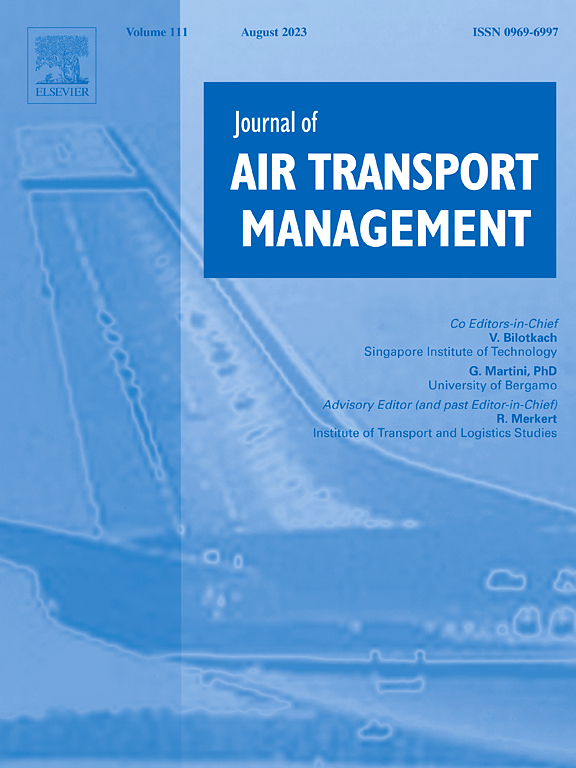自主地面保障设备多智能体任务分配与路径规划
IF 3.6
2区 工程技术
Q2 TRANSPORTATION
引用次数: 0
摘要
我们的目标是利用机场的自主地面支持设备(GSE)为地面处理任务的自动化做出贡献。在日益增长的交通需求下,空侧操作自动化对机场实现更高水平的安全和效率至关重要,需要解决复杂的调度和路径规划问题。为了解决这个问题,我们提出了一个多智能体任务分配和路径规划模型来处理停机坪上的空侧操作。在问题中,将地面服务任务分配给设备,考虑航班时刻表,在特定的时间窗口内安排车辆的行程,避免停机坪与服务道路上车辆的碰撞。我们提出了一个集中的多智能体任务分配和路由模型,该模型旨在优化异构GSE车辆上各种类型地勤任务的分配和路由。我们将分配和路径问题转化为有时间窗的车辆路径问题,采用热启动混合整数线性规划(MILP)模型求解。同时引入非线性目标函数,将MILP模型转化为混合整数非线性规划(MINLP)模型,使服务点占用时间最小化。然后,通过多智能体寻路模型,解决相应的寻路问题,为GSE寻找无碰撞路径。在任务分配率、寻找无冲突路径的性能指标和CPU时间方面,该模型优于以往研究中的分散方法。在路径规划中,与最短路径的平均偏差相当小,这意味着解决方案的质量很高。此外,分配任务的CPU时间比分散分配的CPU时间减少了48%。本文章由计算机程序翻译,如有差异,请以英文原文为准。
Multi-agent task allocation and path planning for autonomous ground support equipment
We aim to contribute to the automation of ground handling tasks using autonomous ground support equipment (GSE) at airports. Automation of airside operations has recently become critical for the airports to achieve higher levels of safety and efficiency under growing traffic demand and requires solving a complex scheduling and path planning problem. To address this problem, we present a multi-agent task allocation and path planning model for handling airside operations on the apron. In the problem, the ground handling tasks are to be allocated to the equipment, the trips of vehicles should be scheduled within specific time windows considering the flight schedules, and the collisions of vehicles on the apron and service roads should be avoided. We present a centralized multi-agent task allocation and routing model which aims to optimize the allocation and routing of various types of ground handling tasks over a heterogeneous set of GSE vehicles. We convert the allocation and routing problem into vehicle routing problem with time windows, pick-ups, deliveries and solve the problem using a warm start mixed integer linear programming (MILP) model. We also introduce a nonlinear objective function which converts the MILP model into a mixed integer nonlinear programming (MINLP) model, to minimize the time service locations at the stands are occupied. Then, we solve the corresponding path finding problem to find collision free paths for the GSE, by the multi-agent path finding model. The proposed model outperforms the decentralized approach in previous research regarding the allocation rate of assigning tasks to vehicles and the performance indicators of finding conflict free paths, and in CPU time. The mean deviations from shortest paths were considerably small in path planning which means that the solution quality was high. Furthermore, the CPU time of allocating tasks has been reduced by 48% compared to the CPU time of decentralized allocation.
求助全文
通过发布文献求助,成功后即可免费获取论文全文。
去求助
来源期刊

Journal of Air Transport Management
TRANSPORTATION-
CiteScore
12.40
自引率
11.70%
发文量
97
期刊介绍:
The Journal of Air Transport Management (JATM) sets out to address, through high quality research articles and authoritative commentary, the major economic, management and policy issues facing the air transport industry today. It offers practitioners and academics an international and dynamic forum for analysis and discussion of these issues, linking research and practice and stimulating interaction between the two. The refereed papers in the journal cover all the major sectors of the industry (airlines, airports, air traffic management) as well as related areas such as tourism management and logistics. Papers are blind reviewed, normally by two referees, chosen for their specialist knowledge. The journal provides independent, original and rigorous analysis in the areas of: • Policy, regulation and law • Strategy • Operations • Marketing • Economics and finance • Sustainability
 求助内容:
求助内容: 应助结果提醒方式:
应助结果提醒方式:


